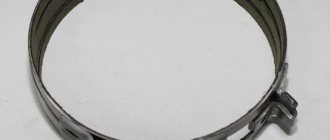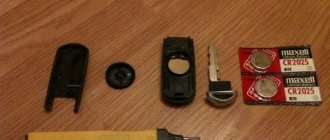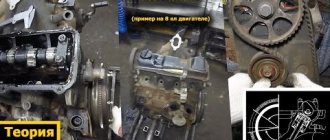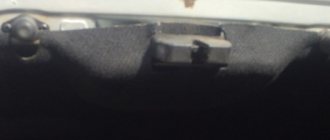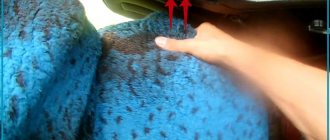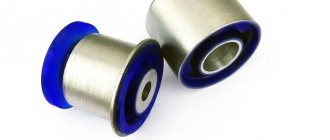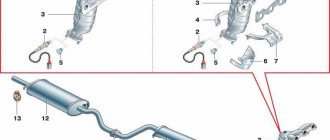Any tire fitter will tell you that not every tire defect can be repaired. Sometimes the damage is so significant that further operation is impossible. Then the question arises of what to choose: repair or replacement of a tubeless tire with a side cut and a puncture in the tire. The solution largely depends on the skill of the technician, the size and location of the problem, and how you plan to use the vehicle. If you need to hold out for several weeks before a scheduled replacement, then the patch will probably hold out.
In the article we will tell you whether the service will always undertake to repair the damage, whether it is worth driving on such tires and why it is dangerous. You will also learn how to fix the problem on your own and what tools you will need to do this.
Is it possible to repair a side cut on a tire and how to seal it
It is possible to repair a wheel with a hole in the side, but this solution is not always advisable. Not every tire shop will take on such work, because, firstly, it requires a lot of experience and skill, and secondly, it is very difficult to complete the task efficiently even for a professional.
Why does this problem occur? Potholes, stones and other sharp objects on the roads are the main causes of punctures, most often they occur on the tread. Repairers are good at repairing such damage, but the situation with side cuts is much more difficult. If such a defect occurs, the car cannot be used for a long time; urgent replacement or competent assistance is required.
How does a tire work?
Before you begin to solve the problem yourself, you need to understand what you are dealing with. Repair work will vary significantly depending on the location of the puncture, as well as the type of tire.
The tire has a complex structure. The main load is borne by the stiffeners. These are two frames, each of which helps to correctly distribute the load on the entire wheel:
- Metal - created from the thinnest wire.
- The frame is made of nylon threads - a synthetic material, distinguished by its strength and lightness; it contains petroleum products.
If you cut a tire crosswise, then in cross-section it will form the letter “C”, which consists of numerous layers. The layer-by-layer structure contributes to wear resistance, strength, and improved traction.
Main elements of a tire:
- Cord frame (cord) is a skeleton that consists of interlacing metal threads with synthetic ones. Most often nylon is used, but sometimes it is cotton or viscose.
- Breaker. There is an additional rigid layer on top of the cord, but it is located only on the working surface and is intended to protect against punctures. The absence of a breaker should be taken into account when repairing side damage to a tire.
- Tread. This is a thick layer of rubber that is located on the outside. It is designed for direct contact with the road surface. The pattern helps improve traction and control movement in the rain. As long as the tread wears gradually and evenly, the cord is protected and the basic functions of the wheel remain normal.
The internal structure of the cord frame is of two types - radial and diagonal, depending on how the threads are arranged among themselves. The first option is preferable from a reliability point of view, so this type is now predominantly produced. The technology involves placing metal wire and nylon parallel to each other, without crossing diagonally, as in the second option.
When repairing a tire, it is also important to know its external structure:
- Boards. This is the outermost section of the tire; they are responsible for its secure fit to the disc. The material here is quite strong due to the additional power rings made of metal wire, so it is very difficult to damage them naturally.
- Sidewalls. Their damage is most undesirable and rare, usually also due to deliberate intent. This is the most voluminous element of the wheel in terms of space occupied. The additional layer of rubber just protects the cord.
- Shoulders - smooth transition to the tread. They are involved during movement, when turns are made, and also when hitting bumps. In this case, punctures occur regularly, and repairmen are well aware of how to repair the side cut on the shoulder of the tire.
- Treadmill. This fragment is constantly in contact with the road, so the largest number of layers is used to create it. This is where most of the damage occurs.
Our production
Why is a tire cut dangerous?
It all depends on its depth. As a rule, if a sharp object penetrates deep enough, the cord layer is damaged. Thin metal wires, as well as nylon cord threads, break, which violates not only the strength of the zone, but also the overall geometry. As a result, even after installing the patch, the reliability of the wheel is questionable; it can explode under excessive loads and even just while driving. The fact is that a torn frame cannot be put back together in any way, and the repair will consist only of the outer layer. Glued rubber cannot always withstand significant internal pressure in combination with external mechanical influences.
Whether you can drive with a tire cut on the side is up to you to decide. But remember that in such a situation there is a high probability of a sudden break. If this happens at high speed, a skid with the possibility of an accident is guaranteed.
Side cut repair
A side cut cannot be repaired on the road, so DIY tubeless tire repairs can only be done in a garage. Only those products in which the length of the longitudinal side cut does not exceed 35 mm, and the transverse cut - 25 mm, are subject to repair.
For repairs, the wheel must be dismantled to provide access to the inside of the tire. The area of the side cut must be cleared of dirt and cleaned with emery cloth or a drill outside and inside the tire. Small cuts can be sealed using raw rubber and a vulcanizer. Vulcanizer can be found among owners of old cars with tube tires. The advantages of raw rubber are that in its initial state it is a plastic mass, and after heating and waiting time it becomes similar in strength to the tire material.
More severe damage is sealed with special reinforced patches to repair the side cut on both sides of the tire according to the instructions for using the patches. Their size should be such that they cover the area of the side cut with a margin of at least 2 cm on each side.
It is possible to operate such tires only with a minimum load. It is better to use them as a spare wheel, since broken cords of lateral damage greatly reduce the load-bearing capacity and reduce the permissible load and speed limit.
What types are there
They are divided into:
- horizontal;
- diagonal;
- vertical.
In some cases it can be doubled in the form of a diverging triangle. Vertical and diagonal types are considered beyond repair.
It is also worth paying attention to how the rubber is cut relative to the cord threads. If along them and the strength of the hull is not significantly compromised, the situation can really be corrected. When they are cut across, the gap is almost impossible to repair. To determine this, you need to know what type of tire you have - radial or diagonal.
In order to understand whether repair is possible, count the number of damaged threads. For example, for trucks there is a rule: if more than 10 pieces are torn, welding the cut on the side of the tire or patching it in any other way is prohibited. In this case, the rubber is sent for disposal, since it is dangerous to use.
How to do work using a repair kit
Tubeless tires can be repaired without removing the wheel. It is enough to jack up the car. This is not very convenient on the rear wheels, but the front wheels can be rotated so that there is easy access to the puncture site. To determine the location of the damage, the wheel must be carefully inspected, constantly turning it. You can usually see the culprit of the problem - a nail or a piece of wire.
If the damage is not visible visually, you can use soapy water and pour it over the inflated tire. Bubbles and foam will be visible at the puncture site.
It must be marked with chalk or a colored marker, and then thoroughly cleaned of dirt, dried and, if possible, degreased. If the width of the puncture or cut is more than 5 mm, then do-it-yourself repairs should be done as a last resort. Such damage can only be repaired in a car service or tire shop.
Before repairing a tire, its pressure should be no more than 0.5 atm. Now the damaged area needs to be cleaned using a spiral file, which is inserted into the hole and rotated several times while pushing. A puncture on the tread lip is difficult to widen, so when purchasing a set, you need to pay attention to a tool with wide handles.
After the hole is cleared, you need to insert a flagellum into the cut part of the awl so that the awl passes through its middle. Do not touch the surface of the flagellum with your hands! The applied tourniquet is lubricated with a thin layer of glue. It is not necessary to cover everything with glue. It is enough to lubricate its middle part a few centimeters.
An awl with a tourniquet is carefully inserted into the puncture hole to such a depth that the middle of the tourniquet is on the inside of the tire. Now you can carefully pull the awl back. Due to the high friction of the harness material and rubber, it will remain in the hole.
The parts of the harness protruding outward must be cut flush with the protector using a stationery knife. Since the mass of the harness is low, subsequent balancing of the wheel can be dispensed with. You can inflate the tire immediately after repair.
Criteria for suitability for repair
Some car enthusiasts, at their own peril and risk, deliberately allow patches for holes 3 and 5 cm in length (with a longitudinal and perpendicular location to the cord threads, respectively). To decide whether to contact a service center or do the work yourself, rely on the type of tire you have.
Radial
The cord threads are located perpendicular to the circle - in this direction the entire structure is most reliable and stable on the roads. They are not intertwined, but are parallel to each other.
The disadvantage of such tires is that after any repair, their quality cannot be restored to their original parameters. So yes, it is possible to repair radial tires with a side cut, but it will only help for a short time, and you will still have to change the tires soon.
Diagonal
In terms of maintainability, this is a better option. If one section is damaged, the overall reliability of the structure remains at a high level due to the strong weave of the threads. Since the load during movement will be distributed evenly, both rigidity and geometry will remain at the same level. In this case, there is only one problem - diagonal cord construction is becoming less and less common.
There are other criteria. For example, a chamber inside the rubber increases the permissible gap value by another centimeter. Be sure to check its integrity - torn thin metal wires can touch and puncture the rubber layer.
With freight transport, the main criterion for repairability is the number of broken threads. If there are more than 10 of them, then the tire is considered unsuitable for further use.
How to determine if a tire can be repaired
To reliably assess the consequences of tire deformation, before repairing the tire, contact a specialized center. The technicians will figure out whether it is possible to continue driving the car or whether it is worth replacing the tires. The main inspection criterion is the width of the seam that needs to be repaired. It is worth considering that it is dangerous to seal holes wider than 40 mm with rubber compounds.
If the craftsmen decide to restore the tire and make a patch, then the restoration process includes the following stages:
- dismantling a tire - before sealing the holes, specialists measure the diameter of the seam;
- trimming and grinding the edges of the hole - high-quality replacement of the blade requires reliable welding of the material;
- applying cementitious material and raw rubber, which allows you to make a reliable patch;
- vulcanization of the tire in a professional chamber, which allows you to reliably seal the rubber;
- applying a reinforced patch to the treated area;
- degreasing the surface and re-applying the cementitious composition;
- tire installation.
The decision to make a patch should be made by experienced specialists who can advise whether it is worth sealing the seam or whether it is necessary to replace the tires. Restoration of rubber, despite the observance of technology, cannot restore the original properties of the frame, so you should ride on such tires carefully.
It is also worth considering that if you are restoring a tire, you must break it in before active use. To avoid negative consequences, we do not recommend driving at high speeds.
Is it possible to repair a side cut on a tire and how to do it: technique
Of course, it is possible to fix the problem. But we note that a cut located in the assembly is very difficult to repair. What technologies are used for repairs?
The most commonly used is a special patch. This is a patch that is made of pressed rubber - it is virtually poreless, so it does not allow air to pass through, and also contains cord materials to ensure rigidity. These threads are needed to keep the breakdown from spreading.
The hot vulcanization method using such a patch is carried out in several stages:
- Inspecting the damaged area, we decide whether it is worth repairing the side cut of the tire and how best to repair the puncture.
- Clean the area (1–1.5 cm from the edges of the hole) using a sander. Processing is carried out on both sides.
- Sanding and smoothing the edges to ensure better adhesion to the repair compound.
- Apply a layer of glue, let it dry, sand again.
- Attaching the patch to the inside of the tire, this ensures the release of air that collects in it. To do this, use a roller and movements from the center to the edges.
- Measuring the depth of the cut.
- Applying hot glue - it should dry in 15-20 minutes.
- The grooves are filled with pieces of rubber, and the top is rolled out with a roller.
- Fastening on a special device - a vulcanizer.
- Curing. The duration of the stage depends on the thickness of the rubber layer. On average, you have to spend 4 minutes per 1 mm with a classic temperature regime (100-120 degrees).
- Decorative polishing.
Tools for repairing tires with a side cut or puncture on a wheel: how to seal a tire
If you want to solve the problem yourself, and this can be done with a minor malfunction, you will need:
- strips of raw material;
- sanding machine or regular sandpaper;
- source of high temperatures - for example, a hair dryer;
- degreasing liquid;
- purchased patch reinforced with cord threads.
We do the repairs ourselves
- Sand the edges of the cut with sandpaper.
- Degrease the work area.
- We fill the holes with rubber and heat it with a hair dryer.
- We clean it using a grinding machine.
- Attaching the patch.
- We balance the wheel.
Popular goods
Repairing a small wheel cut on the side of a tire at a service station
The same algorithm will be used here, but with the use of more complex techniques and equipment. For example, the edges are processed using side cutters, and the rubber is heated with a special vulcanizer, and not with a hairdryer. In addition, the materials themselves will be of higher quality. You won't have to worry about this kind of work.
Restoring tires at home
One of the effective ways to eliminate cut tires is a method consisting of the following steps:
- The size of the cut is measured, if it is within the acceptable limits, you can begin to eliminate it.
- The edges of the cut are ground down with a special fine abrasive to give the damage a bowl shape.
- After treatment with an abrasive, the surface is degreased using gasoline or alcohol. The slot is then filled with raw rubber.
- A tire treated with this method is vulcanized. This process is performed using a special camera or a production hair dryer.
- After vulcanization, the rubber-filled cut is cleaned, a special reinforced patch is glued, and the wheel is balanced.
You can seal the tire in this way with your own hands without involving specialists. In this case, during operation of the repaired tires, wheel runout may occur. To use a sealed tire for a long time, it is better not to load the car and give preference to a measured driving style: increased loads on the wheel can lead to a tire rupture.
We recommend: Replacing a ball joint with your own hands: instructions with photos




